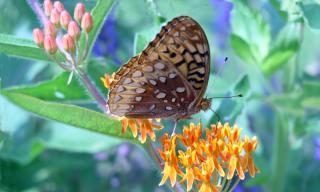Fritillary: A Pretty Butterfly and a Good Pollinator

By Beatriz Moisset
People who are not very familiar with butterflies frequently mistake fritillaries for their more famous distant cousins the monarch butterflies. Most are orange and black like the monarchs, but with a different pattern and some are about the same size. They are as attractive and their life histories are perhaps just as interesting, although they do not make the monarch’s incredible journey all the way to Mexico. Sadly, some species of fritillaries are considered endangered.
The common name comes from a Latin word, fritillus, which means chessboard or dice box. Fritillary is also the name of a flower with an interesting checkered pattern; it is obvious that both the flower and the butterfly get their common name because of such pattern. Another name for these handsome butterflies is silverspots because of the metallic markings on their wings undersides. It is possible that this pattern, similar to a leopard’s spots, serves as camouflage when they are resting in places of dappled sun and shade spots.
There are fourteen species of the so-called greater fritillaries (genus Speyeria) and sixteen lesser fritillaries (genus Bolloria). The greater fritillaries are larger than the lesser ones as their name indicates. Some of them are very hard to tell apart and when seen in flight it is easy to make mistakes.

One of the most familiar ones is the great spangled fritillary because of its large size, abundance, and widespread range. It is found in northern and central United States and southern Canada. It is only missing from northern Canada and some of the southern states. Its complete scientific name is Speyeria cybele; cybele meaning “mountain mother” or “earth mother”.
Like many other butterflies, their caterpillars are very selective about what they eat. They do not go for milkweeds as do monarchs; they prefer violets instead. Without violets, there would be no fritillaries. The adults, on the other hand are thirsty for nectar of many native flowers, such as mints, butterfly weed, common milkweed, Joe-pye-weed and others; but they do not hesitate to visit some non-native flowers such as lilacs, butterfly bush and some thistles. In general they prefer long tubular flowers, but they can also use some easy to reach, more open flowers.
The females emit an enticing aroma called a pheromone that attracts males. The adults mate in the summer; afterwards sometimes females take a nap of a few weeks, called diapause. They emerge from diapause in late summer and lay their eggs near patches of violets. Female great spangled fritillaries seem to be able to find the violets even after they have wilted and blown away. It is possible that they can smell the roots of violets. Curiously, females of other species of fritillaries do not appear to be terribly careful about finding the presence of violets; they seem to choose shaded, weedy places that are likely to favor the growth of violets, thus many eggs are lost when the larvae search in vain for their food and cannot find it. These mothers can afford to be careless because they lay as many as two thousand eggs, so it does not matter if many are lost.
Caterpillars hatch in the fall and go to sleep right away without feeding. They sleep through the winter and will only awaken in the spring at the same time as violet plants begin to grow. The timing is important to the hungry caterpillar. It is feared that global warming may disrupt this synchronization; this would prove catastrophic to fritillary caterpillars. Studies are underway to verify whether this is already taking place.

Additional Resources
Butterflies and Moths of North America: Great Spangled Fritillary, Speyeria cybele
Idaho State University: Speyeria cybele, Great Spangled Fritillary
Butterfly Gardens. Alcinda Lewis. 21st-Century Gardening Series. Brooklyn Botanic Garden. 2007.
